This article written on 14 April 2016 by the LDS News Room appeared in the 18 April 2016 online edition of Meridian Magazine.
George Q. Cannon was one of the best-known Latter-day Saints in the last half of the 19th century. His record covers half a century, a period in which he served as a Church editor and publisher, a member of the Quorum of the Twelve Apostles, a territorial delegate in Congress and a counselor to Church Presidents Brigham Young, John Taylor, Wilford Woodruff and Lorenzo Snow.
The first online installment of the journal of the Mormon leader has been released to the public by the Church Historian’s Press, an imprint of the Church History Department of The Church of Jesus Christ of Latter-day Saints. The free publication, “The Journal of George Q. Cannon,” is available at churchhistorianspress.org.
“The George Q. Cannon journals are among the most important sources of Latter-day Saint history during the latter half of the 19th century,” said Richard E. Turley Jr., assistant Church historian, and recorder and coeditor of the previously published volumes of Cannon’s journals.
“We are delighted as a department to make these remarkable records available to Church members and historians at this time,” said Reid L. Neilson, assistant Church historian, and recorder.
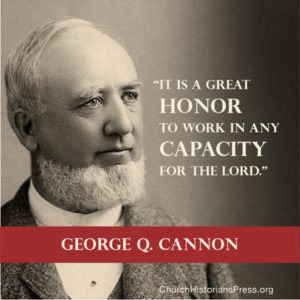 Cannon’s extensive 50-volume journal is one of the most insightful and detailed records in Mormon history. The journal will also be of great interest to scholars of American political and religious history as well as the history of the U.S. West. The total journal contains roughly 2.5 million words. The 1855 to 1875 release contains roughly 270,000 words.
Cannon’s extensive 50-volume journal is one of the most insightful and detailed records in Mormon history. The journal will also be of great interest to scholars of American political and religious history as well as the history of the U.S. West. The total journal contains roughly 2.5 million words. The 1855 to 1875 release contains roughly 270,000 words.
“[President Brigham Young blessed me that] I should be blessed in writing and publishing, and when I should take up the pen to write I should be blessed with wisdom and the Lord would inspire me with thoughts and ideas that what I should write and publish should be acceptable to the people of God,” said Cannon.
Covering 1849 to 1901, Cannon’s journal provides an unfiltered look not only into his remarkable life but also into central Latter-day Saint leadership at a time when the Church was undergoing great change. He began his journal during his mission to Hawaii as a young man and continued writing until nearly the end of his life.
The journal provides insight into many significant events in Latter-day Saint history. The first three volumes of Cannon’s journal, covering 1849 through 1854, were previously published in two print volumes: “The Journals of George Q. Cannon: To California in ’49” and “The Journals of George Q. Cannon: Hawaiian Mission, 1850–1854.”
The initial online release of Cannon’s journal starts where those books left off, beginning with the entry of May 10, 1855, and extending through 1875. Transcripts of additional portions of the journal will be released in later stages. Eventually, all volumes of the journal will be transcribed and published on the Church Historian’s Press website.
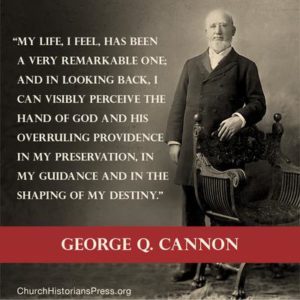 Some passages of the original journal will be withheld in accordance with policies of the Church History Library, where the journal is housed, to redact sacred, private and confidential information, including details about temple ceremonies and names of individuals involved in Church disciplinary councils.
Some passages of the original journal will be withheld in accordance with policies of the Church History Library, where the journal is housed, to redact sacred, private and confidential information, including details about temple ceremonies and names of individuals involved in Church disciplinary councils.
Cannon employed secretaries to help him keep the journal, and extensive portions of it were typed rather than written by hand. Many events were recorded right after they happened, such as an interview in June 1862 with United States President Abraham Lincoln.
In a bid for Utah statehood, representative Latter-day Saints held a constitutional convention in Salt Lake City in the spring of 1862. On April 16, the convention nominated George Q. Cannon to serve as senator of the proposed state. Returning from England, Cannon proceeded to Washington and there met with President Lincoln in the midst of the U.S. Civil War.
Elder Cannon said of President Lincoln, “He looks much better than I expected he would do from my knowledge of the cares and labors of his position, and is quite humorous, scarcely permitting a visit to pass without uttering some joke. He received us very kindly and without formality. … He was quite noncommittal respecting our admission [to statehood], having no wish seemingly to commit himself upon the subject.”
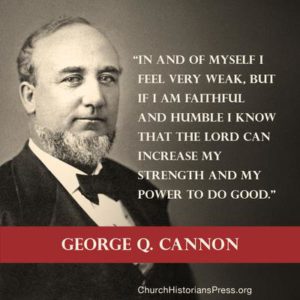 In January 1873, Cannon made a journal entry about the political plight of the Latter-day Saints. “The modern politician is a moral coward. He has not the courage to defend a weak, unpopular side, especially if the question of ‘Mormonism’ be involved. They are as afraid of being suspected of having any sympathy with that, as they would be of the contagion of small-pox.”
In January 1873, Cannon made a journal entry about the political plight of the Latter-day Saints. “The modern politician is a moral coward. He has not the courage to defend a weak, unpopular side, especially if the question of ‘Mormonism’ be involved. They are as afraid of being suspected of having any sympathy with that, as they would be of the contagion of small-pox.”
The 50-year time span covered in the journal allows readers to see wide-sweeping change not only in the Church but also in politics, technology, travel, and other areas. Topics found in the journal include Cannon’s many travels in the United States and Europe; his counsel to and relationships with his family, which consisted of six wives and 43 children; his meetings with congressmen and senators; his close relationships with Church leaders and his counsel to Church members; his life in prison after being arrested for practicing plural marriage; his financial dealings; and his devotion to the Church.
A short-term exhibit featuring original journals, photographs and other historical documents titled “George Q. Cannon: A Mighty Instrument” will be on display at the Church History Library from April 12 to May 13.
Previous publications of the Church Historian’s Press include a dozen volumes of the Joseph Smith Papers and a collection of documents chronicling the history of the Relief Society in the 19th century.
About Guest Author
Twitter •


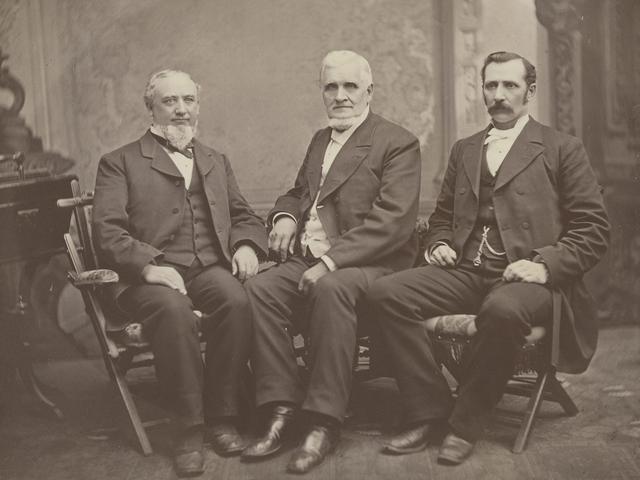
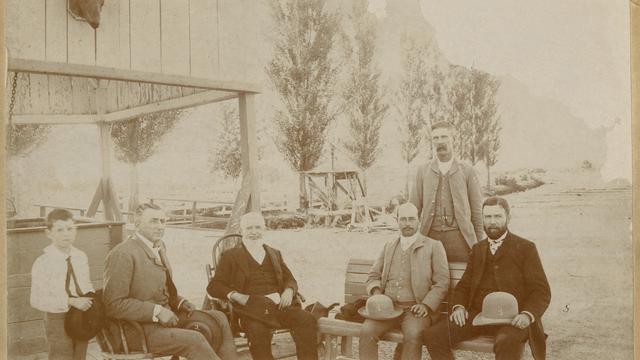
 Watch a video about the restoration of the gospel on lds.org
Watch a video about the restoration of the gospel on lds.org